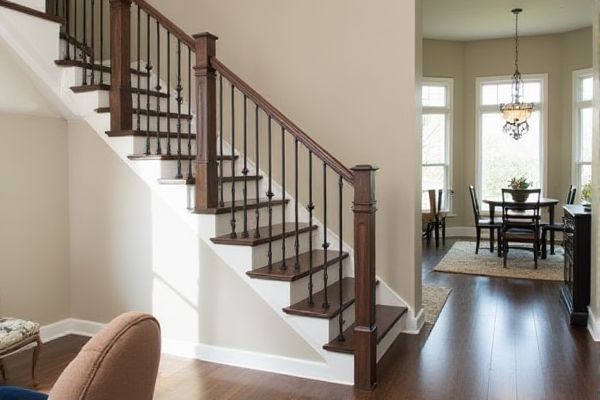
Steel balusters offer superior strength, durability, and a modern aesthetic, making them ideal for both indoor and outdoor stair railings, while vinyl balusters provide a low-maintenance, cost-effective option resistant to moisture and rot but may lack the same level of structural integrity and design versatility. Discover which baluster type best fits Your home improvement needs by exploring the detailed comparison in the rest of this article.
Table of Comparison
| Feature | Steel Baluster | Vinyl Baluster |
|---|---|---|
| Material | Durable steel, often powder-coated | Lightweight, weather-resistant PVC |
| Durability | High resistance to impact and corrosion with proper coating | Resistant to moisture and UV, but can crack over time |
| Maintenance | Low maintenance; occasional cleaning and rust check | Very low maintenance; easy to clean with soap and water |
| Appearance | Modern, sleek, offering industrial or contemporary look | Traditional or classic look, available in various colors |
| Cost | Moderate to high initial cost | Lower initial cost |
| Installation | Requires professional installation for welding or fastening | Easy DIY installation with snap-in or screw-in designs |
| Environmental Impact | Recyclable steel with long lifespan | Non-biodegradable plastic, less eco-friendly |
Introduction to Steel and Vinyl Balusters
Steel balusters offer exceptional strength, durability, and a modern aesthetic, making them ideal for outdoor railings or high-traffic areas. Vinyl balusters provide low maintenance and resistance to moisture, perfect for budget-friendly, weather-resistant railing solutions. Your choice depends on factors like desired look, cost, and environmental exposure.
Material Composition and Properties
Steel balusters consist primarily of carbon steel or stainless steel, offering high strength, durability, and resistance to bending or impact, making them ideal for structural and aesthetic applications in stair railings. Vinyl balusters are made from polyvinyl chloride (PVC) or similar synthetic polymers, providing lightweight, corrosion-resistant, and low-maintenance characteristics but generally lower strength compared to steel. The material composition directly influences properties such as weather resistance, load-bearing capacity, and longevity, with steel excelling in durability and vinyl favored for moisture resistance and ease of installation.
Visual Appeal and Aesthetic Options
Steel balusters offer a sleek, modern look with high durability and a variety of finishes such as matte black, brushed nickel, or stainless steel, enhancing contemporary or industrial design themes. Vinyl balusters provide a wide range of colors and styles, often mimicking wood grain textures, which suit traditional or coastal aesthetics while requiring minimal maintenance. Choosing between steel and vinyl balusters depends on the desired balance between visual sophistication and versatility in aesthetic options.
Durability and Longevity
Steel balusters offer superior durability and longevity, resisting weathering, corrosion, and physical damage better than vinyl alternatives. Vinyl balusters can be prone to cracking, fading, and warping over time, especially in extreme temperatures or direct sunlight. Choosing steel balusters ensures your railing system maintains structural integrity and aesthetic appeal for decades with minimal maintenance.
Maintenance Requirements
Steel balusters require minimal maintenance, offering durability with occasional cleaning and rust prevention to maintain their appearance. Vinyl balusters are virtually maintenance-free, resisting fading, peeling, and moisture damage, making them ideal for low-upkeep applications. You can choose steel for a robust, long-lasting option or vinyl for ease of care and lasting aesthetics.
Cost Comparison
Steel balusters generally have a higher upfront cost due to their durability and strength, often ranging from $15 to $30 per baluster, while vinyl balusters are more budget-friendly, typically costing between $2 and $10 each. Installation expenses for steel balusters may also be higher because of the need for specialized tools and skills compared to the easier, faster installation of vinyl balusters. Over time, steel balusters tend to offer better long-term value due to their resistance to damage and lower maintenance requirements, whereas vinyl may require periodic replacement due to wear.
Installation Process and Ease
Steel balusters offer a straightforward installation process due to their uniform shape and pre-drilled holes, allowing for quick attachment to stair rails and posts with minimal tools. Vinyl balusters are lightweight and easy to cut, making them simple to install, especially for DIY projects, but may require careful handling to avoid cracking or warping. Your choice will depend on whether you prioritize the durability and rigidity of steel or the flexibility and ease of vinyl for your railing system.
Weather and Environmental Resistance
Steel balusters offer exceptional weather and environmental resistance due to their durability and ability to withstand harsh conditions such as rain, snow, and UV exposure without warping or cracking. Vinyl balusters are also resistant to moisture and corrosion but may become brittle or fade over time when exposed to prolonged sunlight or extreme temperatures. Your choice of baluster should consider the local climate and maintenance preferences to ensure long-lasting performance and aesthetic appeal.
Safety and Structural Integrity
Steel balusters provide superior safety and structural integrity due to their high tensile strength and resistance to impact, making them ideal for areas requiring enhanced durability and load-bearing capacity. Vinyl balusters, while resistant to moisture and corrosion, generally lack the rigidity and strength of steel, which may compromise safety in high-traffic or heavy-use settings. Choosing steel balusters ensures long-term stability and compliance with stringent building codes focused on robust safety standards.
Choosing the Right Baluster for Your Project
Choosing the right baluster depends on durability, maintenance, and aesthetic preferences. Steel balusters offer superior strength and a sleek, modern look with low maintenance, ideal for exterior applications exposed to weather. Vinyl balusters provide affordable, moisture-resistant options with easy installation, suited for budget-conscious projects requiring minimal upkeep.
 homyna.com
homyna.com